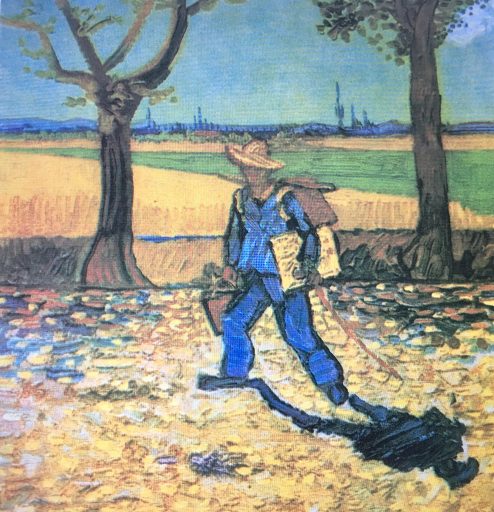MUTHESIUS alters realities
Visitors stroll around the urban space of Landshut and encounter art in a variety of inspiring and stimulating ways. It is around 8 p.m., and the LAProjects gallery is filling up. The opening of the exhibition entitled “Escape of the Visible into the Invisible” is beginning. Groups of people mingle in the charming exhibition spaces, greeting the well-known gallery owner and host. On the walls are works by Muthesius; a selection from various series of his works.


There is also what Muthesius calls a BROKEN GOLD with the title “Hommage à Vincent”. A square-shaped work in gold leaf, reminiscent of a painting in which the great pioneer of modernism, Vincent van Gogh, painted himself on his way to work. He is carrying a golden picture under his arm.
The guests at the gallery are viewing everything with interest and talking amongst themselves, when suddenly a man, who was also among the guests, leaves the room and then comes back in carrying a large sports bag. He is a quiet person, yet he knows how to make his presence felt. The astonished guests realise that someone is making room to unpack his sports bag right in the middle of the crowd. Disconcerted, they step back, murmuring. The murmuring grows louder when they realise that a chainsaw is being unpacked from the bag. The man walks over to the wall where the golden picture is hanging, takes it down and places it on a wooden box. Then he starts up the grim power tool – and takes the saw to the centre of the picture! He starts sawing. “Can he do that?” asks one of the guests. Curious, the surprised bystanders watch the deft, well-versed procedure.

Jörg W. Ludwig, the owner of the gallery, has also joined the proceedings. In suspense, the visitors follow the actions of the man who, it later turns out, is the artist and creator of the work. Deep in concentration, he uses the rough tool to remove an almost perfect square from the picture. Gold and yellow wooden splinters, fibres gleaming like straw in the sun, fall to the ground. One cannot help but be reminded of Van Gogh.

At the end a work of art remains, minus its centre. Is its centre really missing? Or is the gaping void at the heart of the golden work symbolic of so much in our society today?

